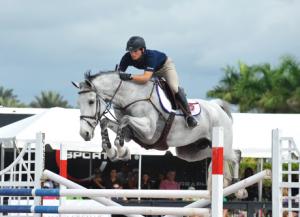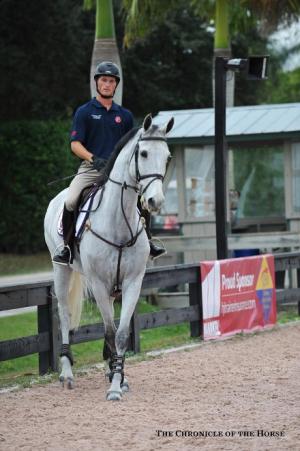By Nancy Brannon, Ph.D.
Being selected by the United States Equestrian Federation (USEF) to ride in the ninth annual George Morris Horsemastership Training Session is a high honor for young riders. Only 12 riders are selected, and these riders represent the top young riders in the U.S. – riders who have great potential. The 5-day Training Session, presented by the USHJA, was held at the Palm Beach International Equestrian Center in Wellington, Florida over the holidays, December 29, 2014 – January 3, 2015. One of the 12 riders chosen to participate was Bowers Cone of Collierville, Tennessee. Bowers shared his experiences and some of what he learned from The Master, George Morris.
Morris teaches classically correct riding principles in the training session designed to develop young horsemasters for future U.S. Equestrian teams. Morris’ insights in the basic, correct riding and training principles, while oriented toward hunters and jumpers, are applicable to all riding disciplines. Principles such as how to create impulsion, straightness, which is necessary for back-to-front collection, bending the horse in accordance with curved lines, flexion, transitions, establishing and maintaining rhythm, suppling with lateral work, collection and balance, and the rider learning to be light on the horse’s back are important to all disciplines. His emphasis on neatness, organization, paying attention, and learning as much as one can, apply to all aspects of life, as well as riding.
So on the first day of the clinic, Morris began with the basic foundation of flat work, upon which all other types of work the horse can learn are based. Morris introduced the riders to his established flat work regimen and emphasized dressage skills as the way to achieve correctness. “Basic dressage and classical riding, of which we can’t ever learn enough, is a positive from every perspective of the horse,” said George Morris. “It leads to physical improvement, mental improvement and emotional improvement, and you have obedience. No matter if you go to a cross-rail, an oxer, a combination, or water—the horse is ready to listen. And this isn’t new! This is a very ancient method of training with horses. The horse has to be well ridden, not with all these tricks and gimmicks.”
Bowers Cone related that Morris emphasized how important flat work is to jumping. “Without correct flat work, you can’t be successful in jumping,” Cone said. “When doing flat work, the reward for the horse doing something well and correctly is to get off his back and let him put his head down a bit, without letting the reins slip through or allowing the horse to scratch his head on his leg. Getting off their backs and allowing them to stretch their necks shows them they did something well. It’s what Morris calls ‘tough love,” and he says horses like ‘tough love.’”
Day two of the clinic progressed to gymnastics and work on rider position over fences. Position, Morris explained, is one of the most vital aids a rider has—and the most frequently overlooked.
“I feel position is very important for function,” said Morris. “Sit down and straight but not backward; keep a light seat; don’t over-exaggerate,” Morris told the riders. Bowers explained further: “Morris likes three-point contact, with the rider’s weight in the heels and butt out of the saddle,” Cone explained. Three-point contact denotes both legs and the rider’s seat, rather than two-point contact, when the rider is out of the saddle. “This position relaxes the horse’s back and allows the horse to get a better jump,” Bowers said. Morris talked about the popularity in the U.S. of the full seat, the driving seat, but said this is not good for the horse. Morris showed riders how to ride on contact with a higher hand, with the half-seat, and worked the riders over small in-and-outs and gymnastic exercises.
Day three focused on the mechanics of jumping open water. In this case, maintaining pace and staying “behind” the horse a little with a full seat is the most appropriate position to take. Morris emphasized proper, solid contact with the horse’s mouth and the use of the half-halt as a “check” coming into jumps like the water jump.
Day four was no stirrups lesson day. Bowers said, “Riding with no stirrups is the key to developing a tighter leg and a lighter seat, because riding without stirrups strengthens your lower leg.” Lessons this day followed up on the first day’s flat work, introducing more bends, shoulder-ins, haunches-in, and stretching the horse. Morris demonstrated how to correct a horse with an unusually high head. This particular horse had a habit of lifting his head and shaking his head to take the reins. Morris used his legs and hands to settle the horse, then demonstrated the leg to hand work, raising his hands and using a tighter contact to prevent the horse taking away the reins. Morris improved the horse’s head carriage through circles, serpentines, and other lateral work, and he used transitions, e.g., walk to canter, canter to trot, to soften the horse’s mouth.
Day five allowed the riders to incorporate all they had learned so far and use it in jumping a course of fences. For the first 20 minutes, Morris watched the riders warm up freely on the flat to show what they had learned. Then the riders got to watch Morris jump a horse back and forth over a small oxer, using various distances and speeds. He advised letting the horse use his head, and maybe even get a rub on the fence. This will teach the horse to use his body more and rely less on the rider’s hands. Then the riders jumped the course of fences, demonstrating what they had learned and the improvements they had made. Bowers worked on slowing his upper body over fences, which tended to be quick. He learned to keep his eyes up, relax, and not help the horse so much. Slowing down the body allows the horse to do all the work.
This was the second time Bowers had ridden in a George Morris clinic. The previous one was in September 2014, so Morris already knew Cone and was familiar with his horse. “He is incredibly knowledgeable,” Cone said. “Morris really knows his riding. It’s not the rider’s accomplishments that are important; it’s what the riders can learn and take from a clinic that’s important. He’s hard on the riders because he knows all have potential and can go far, but need someone to hold them to being meticulous, to doing everything right. He does this so that in the future, these riders can train young horses correctly.” Morris told the riders: “Educate your horse. Set him up for success!” Morris also emphasized the importance of these riders being able to teach others what they have learned.
Bowers said that both clinics he has taken from George Morris have been great experiences. But he liked this one better because it was five days instead of three, and he had more time to learn from The Master.
The Mid-South Horse Review is grateful to Haley Burton for sharing her photos with our readers. Haley Burton at The Chronicle of the Horse has written detailed articles about each day’s activities at the 2015 George Morris Horsemastership Training Sessions. Read more at: http://www.chronofhorse.com/content/2015-GMHM.
Being selected by the United States Equestrian Federation (USEF) to ride in the ninth annual George Morris Horsemastership Training Session is a high honor for young riders. Only 12 riders are selected, and these riders represent the top young riders in the U.S. – riders who have great potential. The 5-day Training Session, presented by the USHJA, was held at the Palm Beach International Equestrian Center in Wellington, Florida over the holidays, December 29, 2014 – January 3, 2015. One of the 12 riders chosen to participate was Bowers Cone of Collierville, Tennessee. Bowers shared his experiences and some of what he learned from The Master, George Morris.
Morris teaches classically correct riding principles in the training session designed to develop young horsemasters for future U.S. Equestrian teams. Morris’ insights in the basic, correct riding and training principles, while oriented toward hunters and jumpers, are applicable to all riding disciplines. Principles such as how to create impulsion, straightness, which is necessary for back-to-front collection, bending the horse in accordance with curved lines, flexion, transitions, establishing and maintaining rhythm, suppling with lateral work, collection and balance, and the rider learning to be light on the horse’s back are important to all disciplines. His emphasis on neatness, organization, paying attention, and learning as much as one can, apply to all aspects of life, as well as riding.
So on the first day of the clinic, Morris began with the basic foundation of flat work, upon which all other types of work the horse can learn are based. Morris introduced the riders to his established flat work regimen and emphasized dressage skills as the way to achieve correctness. “Basic dressage and classical riding, of which we can’t ever learn enough, is a positive from every perspective of the horse,” said George Morris. “It leads to physical improvement, mental improvement and emotional improvement, and you have obedience. No matter if you go to a cross-rail, an oxer, a combination, or water—the horse is ready to listen. And this isn’t new! This is a very ancient method of training with horses. The horse has to be well ridden, not with all these tricks and gimmicks.”
Bowers Cone related that Morris emphasized how important flat work is to jumping. “Without correct flat work, you can’t be successful in jumping,” Cone said. “When doing flat work, the reward for the horse doing something well and correctly is to get off his back and let him put his head down a bit, without letting the reins slip through or allowing the horse to scratch his head on his leg. Getting off their backs and allowing them to stretch their necks shows them they did something well. It’s what Morris calls ‘tough love,” and he says horses like ‘tough love.’”
Day two of the clinic progressed to gymnastics and work on rider position over fences. Position, Morris explained, is one of the most vital aids a rider has—and the most frequently overlooked.
“I feel position is very important for function,” said Morris. “Sit down and straight but not backward; keep a light seat; don’t over-exaggerate,” Morris told the riders. Bowers explained further: “Morris likes three-point contact, with the rider’s weight in the heels and butt out of the saddle,” Cone explained. Three-point contact denotes both legs and the rider’s seat, rather than two-point contact, when the rider is out of the saddle. “This position relaxes the horse’s back and allows the horse to get a better jump,” Bowers said. Morris talked about the popularity in the U.S. of the full seat, the driving seat, but said this is not good for the horse. Morris showed riders how to ride on contact with a higher hand, with the half-seat, and worked the riders over small in-and-outs and gymnastic exercises.
Day three focused on the mechanics of jumping open water. In this case, maintaining pace and staying “behind” the horse a little with a full seat is the most appropriate position to take. Morris emphasized proper, solid contact with the horse’s mouth and the use of the half-halt as a “check” coming into jumps like the water jump.
Day four was no stirrups lesson day. Bowers said, “Riding with no stirrups is the key to developing a tighter leg and a lighter seat, because riding without stirrups strengthens your lower leg.” Lessons this day followed up on the first day’s flat work, introducing more bends, shoulder-ins, haunches-in, and stretching the horse. Morris demonstrated how to correct a horse with an unusually high head. This particular horse had a habit of lifting his head and shaking his head to take the reins. Morris used his legs and hands to settle the horse, then demonstrated the leg to hand work, raising his hands and using a tighter contact to prevent the horse taking away the reins. Morris improved the horse’s head carriage through circles, serpentines, and other lateral work, and he used transitions, e.g., walk to canter, canter to trot, to soften the horse’s mouth.
Day five allowed the riders to incorporate all they had learned so far and use it in jumping a course of fences. For the first 20 minutes, Morris watched the riders warm up freely on the flat to show what they had learned. Then the riders got to watch Morris jump a horse back and forth over a small oxer, using various distances and speeds. He advised letting the horse use his head, and maybe even get a rub on the fence. This will teach the horse to use his body more and rely less on the rider’s hands. Then the riders jumped the course of fences, demonstrating what they had learned and the improvements they had made. Bowers worked on slowing his upper body over fences, which tended to be quick. He learned to keep his eyes up, relax, and not help the horse so much. Slowing down the body allows the horse to do all the work.
This was the second time Bowers had ridden in a George Morris clinic. The previous one was in September 2014, so Morris already knew Cone and was familiar with his horse. “He is incredibly knowledgeable,” Cone said. “Morris really knows his riding. It’s not the rider’s accomplishments that are important; it’s what the riders can learn and take from a clinic that’s important. He’s hard on the riders because he knows all have potential and can go far, but need someone to hold them to being meticulous, to doing everything right. He does this so that in the future, these riders can train young horses correctly.” Morris told the riders: “Educate your horse. Set him up for success!” Morris also emphasized the importance of these riders being able to teach others what they have learned.
Bowers said that both clinics he has taken from George Morris have been great experiences. But he liked this one better because it was five days instead of three, and he had more time to learn from The Master.
The Mid-South Horse Review is grateful to Haley Burton for sharing her photos with our readers. Haley Burton at The Chronicle of the Horse has written detailed articles about each day’s activities at the 2015 George Morris Horsemastership Training Sessions. Read more at: http://www.chronofhorse.com/content/2015-GMHM.











